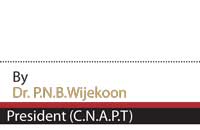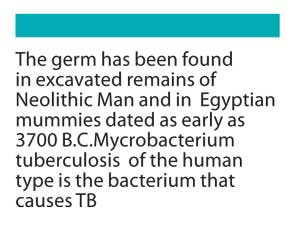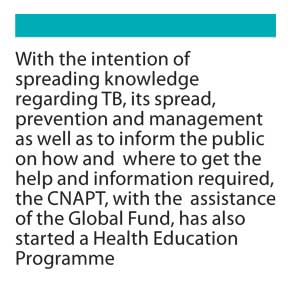Reply To:
Name - Reply Comment
Last Updated : 2024-04-26 18:26:00
 The World TB day which is held each year on the 24th of March is intended to promote awareness, knowledge and motivation for action against tuberculosis worldwide .TB was identified 136 years ago, after the discovery of the Koch’s bacillus. Even today TB remains an epidemic in much of the world despite the fact that effective cures have been made available for decades.
The World TB day which is held each year on the 24th of March is intended to promote awareness, knowledge and motivation for action against tuberculosis worldwide .TB was identified 136 years ago, after the discovery of the Koch’s bacillus. Even today TB remains an epidemic in much of the world despite the fact that effective cures have been made available for decades.
 This greatest killer of human beings in all history is still at work despite many scientific breakthroughs and innovations.
This greatest killer of human beings in all history is still at work despite many scientific breakthroughs and innovations.
Tuberculosis (TB) is a deadly disease which raised its head, almost from the time of evolution. Over the years the disease had killed billions worldwide. The germ has been found in excavated remains of Neolithic Man and in Egyptian mummies dated as early as 3700 B.C.Mycrobacterium tuberculosis of the human type is the bacterium that causes TB.
The bacterium avoided detection by researchers for centuries until Dr. Robert Koch discovered it on March 24th 1882. At the time of Koch’s announcement. TB was raging throughout Europe and the Americas, causing the deaths of one in seven people, this breakthrough discovery enabled the diagnosis and cure of this lethal disease.
However TB assumed by many to be a bygone disease has returned with a vengeance. Associated once with turn-of-the-century romantic poets. TB is again posing a serious health threat in the industrialized world and is spreading rampantly in the developing world. The World Health Organisation (WHO) has warned of a global TB resurgence that could affect approximately 90 million people worldwide within the next decade, and TB is the only disease to be declared a “global emergency”
 Considered a dreaded disease in Sri Lanka during the past, TB has been receiving less public attention in recent times. This is perhaps due to the fact that the threat has dwindled over the years due to the availability of efficacious modern medicines. However this misconception has led to a callous disregard of the disease, which has resulted in an increased number of reported cases.
Considered a dreaded disease in Sri Lanka during the past, TB has been receiving less public attention in recent times. This is perhaps due to the fact that the threat has dwindled over the years due to the availability of efficacious modern medicines. However this misconception has led to a callous disregard of the disease, which has resulted in an increased number of reported cases.
TB has become a public health risk and a virulent killer, even in the developed world, which for decades thought that it had rid itself of it , where its spread has become increasingly out of control.
Over 95% of the infected succumb to the disease making TB responsible for more than a quarter of avoidable adult deaths in the developing world. The number of TB cases is on the rise in Denmark, Norway, the Netherlands, Italy, Britain, the US and may other industrialized, countries, say WHO official who warn that the crisis will grow unless immediate action is taken.
Fortunately only 10% of the people infected with the bacteria will actually develop the disease at varying points in their lifetime.
A persistent cough, often associated with fever, tiredness. loss of appetite, loss of weight and coughing out blood should alert everyone to the possibility of TB infection. A positive Tuberculin (Mantaux) test is of little value to Sri Lankans, since a significant percentage of the population has had a BCG vaccination and some may have a harmless, non- progressive, primary infection A negative test however rules out TB.
Examining sputum samples and finding the germ is the most effective way to diagnose the infection. If there are any questionable symptoms the person should seek proper medical advice and help, as these services are readily available in the country.
Both patients and their families should remember that in general TB is curable, with early detection  making it much easier to treat.
making it much easier to treat.
Only people with an active disease can spread it to others. It can spread from inhaling TB bacilli that have been coughed up, sneezed or in droplets spread while taking if left untreated a person with active TB will typically infect around 10-15 people a year. Further, unsanitary living conditions, a poor state of general health and malnutrition will make a person much more vulnerable to the disease.
Use of the Directly Observed Treatment Short Course, (DOTS), has proven to be the most successful and cost effective course of treatment used the world over. DOTS helps to make a patient non-infective within a period of two weeks, and completely cures within 6 -8 months.
Represents a major break through in controlling tuberculosis. No other TB control strategy comes close to being as efficacious and as affordable DOTS.
The advantages to the community by using the DOTS strategy are numerous.
A. Cure the patient
No other TB control strategy has consistently demonstrated such high cure rates. DOTS produces cure rates as high as 95 percent, even in the poorest of countries. TB programme not using DOTS often cure only 40 percent of their patients.
B. Prevents new infections
DOTS stops the TB Bacillus at the source by curing the infectious patient. A patient who is not cured will infect, on average, 10 to 15 other people every year.
C. Cost Effective
A six month supply of medicine for DOTS costs only $ 11 per patient in some parts of the World. This can be less than the price of a few bottles of aspirin. The World Bank has ranked the DOTS strategy as one of the most cost effective of all health interventions.
D. Community Based
Dots have been demonstrated to add as many years of life by the currently available protease inhibitors to HIV positive people. Yet, the medicines used for DOTS are however not hundred percent effective.
E. Protects the workforce
Nearly 80 percent of those ill with TB are in their most economically productive years of life. These youthful TB patients represent a workforce nearly as large as the number of people employed by the world 20 biggest international corporations.
The Ceylon National Association for the Prevention of Tuberculosis (CNAPT) Initiatives in Sri Lanka
It has been recorded that in countries poorer than Sri Lanka, such as Nepal and Bangladesh, (with per capita GNP of around $ 200 compared to a per capita GNP of US $840 for Sri Lanka more than 90% of Tuberculosis patients can be cured with the emergence of multi drug resistant Tuberculosis
controlled treatment.
However compared to other South Asian countries, Sri Lanka is far ahead in terms of life expectancy, literacy, and material and infant mortality. This is a consistent source of amazement to developed countries who wonder how we maintain indices comparable to a developed country despite the previous civil war. The answer lies in the solid infrastructure and the standard of literacy and education of our population. It would be tragic if the TB situation in Sri Lanka were allowed to deteriorate in spite of possessing such a proud record of healthcare.
This is where the CNAPT steps in Educating the public of the most important aspects of TB eradication. The CNAPT has been at the forefront of the campaign for the education of Sri Lankans. Over the last 68 years, the CNAPT has worked in partnership with the Ministry of Health, and a diverse range of civil society partners to promote knowledge and understanding of the disease amongst the vulnerable section of the population and improving access to proper medical care.
With the intention of spreading knowledge regarding TB, its spread, prevention and management as well as to inform the public on how and where to get the help and information required, the CNAPT, with the assistance of the Global Fund, has also started a Health
Education Programme.
Despite the achievements many TB patients remain undiagnosed Escalated community involvement coupled with the harnessing of related elements could be the answer to combating this lethal disease and the CNAPT is committed to being a forerunner in fulfilling this goal.
Despite the CNAPT’s achievements many TB patients remain undiagnosed, Escalated community involvement coupled with the harnessing of related elements could be the answer to combating this lethal disease.
Special hospital facilities were non-existent for children affected by TB. The CNAPT remedied this by constructing three children’s wards Welisara Children’s Ward(1952), Hawke Memorial Ward, Kandana (1955) and Clarence Nathanieliz Memorial Ward Welisara (1960) which provided a total of 165 beds exclusively for children. The total cost of Rs.900,000 was raised through the efforts of the CNAPT.
As early as 1950 the CNAPT approached the Ceylon Turf Club regarding the financial issues of TB patients. The Club organized a “TB Race Meet” which grossed a sum of Rs. 74,633 and a donation of RS 71,422 from the club enabled the association to grant financial support to selected patients and families. A government imitated financial programme was established only in 1953.
Since its inception the association has concentrated heavily on health education. The objective of the programme is to convey to the public that TB could be cured, patients must take prescribed treatment and those with suggestive symptoms should be screened for the disease. The programme also included lecture to specifically targeted groups, talks via electronic media participation at public exhibition and the distribution of TB related literature. The appointment of permanent health education furthered this cause.
The proximity of the Health Education Centre to the Colombo Museum makes it accessible to any visitors of the Museum who wish to visit the CNAPT’s Health Education Centre.
Due to the rapid advancement of TB medical treatment many functions of the CNAPT have been made redundant and today the association concentrates primarily on promoting health education.
A drop in TB incidence has necessitated the wards. The BCG vaccination administered at birth has almost negated TB in children and has resulted in the closure of the children’s wards. The reduction of the duration of treatment from 4 years to 6 months has made it easier for patients to carry on with their everyday routines with the least degree of inconvenience and the stigma attached to TB has all but disappeared.

Add comment
Comments will be edited (grammar, spelling and slang) and authorized at the discretion of Daily Mirror online. The website also has the right not to publish selected comments.
Reply To:
Name - Reply Comment
US authorities are currently reviewing the manifest of every cargo aboard MV
On March 26, a couple arriving from Thailand was arrested with 88 live animal
According to villagers from Naula-Moragolla out of 105 families 80 can afford
Is the situation in Sri Lanka so grim that locals harbour hope that they coul

8 minute ago
2 hours ago